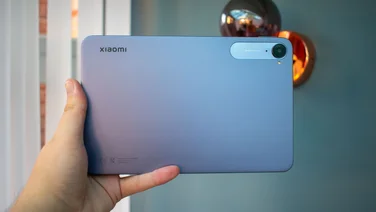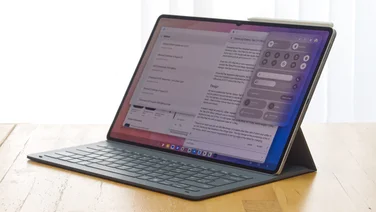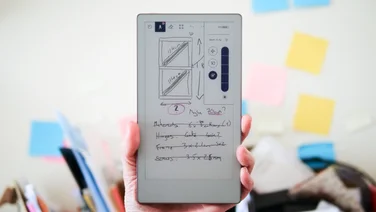To help us provide you with free impartial advice, we may earn a commission if you buy through links on our site. Learn more
- Samsung Galaxy Tab S9 review: What you need to know
- Samsung Galaxy Tab S9 review: Price and competition
- Samsung Galaxy Tab S9 review: Design and key features
- Samsung Galaxy Tab S9 review: Display
- Samsung Galaxy Tab S9 review: Performance and battery life
- Samsung Galaxy Tab S9 review: Software
- Samsung Galaxy Tab S9 review: Verdict










- Vibrant AMOLED display
- Excellent S Pen in the box
- Top tier performance
- Battery life somewhat underwhelming
- No charger in box
- Android still lags behind iOS for tablets
When it comes to premium Android tablet options, no one has you covered like Samsung. Alongside the super-sized Samsung Galaxy Tab S9 Ultra and the mid-sized Galaxy Tab S9 Plus sits a more compact premium offering: the Galaxy Tab S9.
Specified and priced to undercut the 11in iPad Pro, it supplies top-notch performance, an atypically robust design, an outstanding OLED display, and a bundled-in stylus for around £800. Indeed, as much as we liked its bigger brothers, the Galaxy Tab S9 could very well represent the best Samsung tablet for most people.
Samsung Galaxy Tab S9 review: What you need to know
The Samsung Galaxy Tab S9 is the entry model of the brand’s premium tablet range, coming in smaller than both the Galaxy Tab S9 Ultra and the Galaxy Tab S9 Plus with an 11in display.
Unlike last year’s Galaxy Tab S8, that 11in display is an AMOLED panel, with all of the vibrant benefits this entails. You also get a 120Hz maximum refresh rate and a sharp 1,600 x 2,560 resolution.
This tablet won’t be found wanting for power either, courtesy of the same souped-up Snapdragon 8 Gen 2 processor that powers the larger models in the range, with either 8GB or 12GB of RAM. Those memory choices come accompanied by either 128GB or 256GB of storage.
One of the stand-out inclusions here, as with the rest of the Galaxy Tab S9 range, is the inclusion of Samsung’s excellent S Pen stylus. One thing you don’t get in the box, however, is a charger, though the Galaxy Tab S9 does support up to 45W wired charging.
READ NEXT: The best Android tablets to buy
Samsung Galaxy Tab S9 review: Price and competition
Prices for the Samsung Galaxy Tab S9 start from £799 for the Wi-Fi-only model with 8GB of RAM and 128GB of storage, moving up to £899 for the 256GB model. Adding 5G to the equation bumps those prices to £949 and £1,049 respectively.
This pricing means that the Galaxy Tab S9 undercuts the current 11in iPad Pro by £100. That’s quite obviously the aim here, as there are precious few other Android tablets hovering around this premium price point. The closest Android rival I can think of is the Lenovo Tab P12 Pro, but this is an ageing tablet that ‘only’ sold for £750 at launch.










Most high-profile Android tablets of this size will cost you hundreds less, such as the Google Pixel Tablet for £599 and the OnePlus Pad for £449. Somewhat unexpectedly, then, Samsung has carved itself something of a niche simply by sticking to the premium 11in Android tablet script.
Samsung Galaxy Tab S9 review: Design and key features
Samsung isn’t trying anything different with the Galaxy Tab S9’s design, at least visually. It’s another thin (5.9mm) and light (498g) full-sized tablet with flat edges and an all-metal body.
Around the front, Samsung has once again adopted the Apple approach of offering uniform display bezels all the way around, making it easy to grip in any orientation. Speaking of which, Samsung clearly favours landscape, as evidenced by the positioning of the logo on the rear, not to mention a 16:10 aspect ratio display.










As with other tablets in the family, this makes the Galaxy Tab S9 feel a little odd when held in portrait view, but perfectly at home when playing media content in landscape. Samsung’s orientation preference is also obvious when you note the four AKG-tuned speakers, which are positioned on the top and bottom of the two shorter edges. Their output is crisp and clear, even with the volume cranked up quite high.
While the Galaxy Tab S9 looks very similar to previous models, that’s not to say that the company hasn’t made meaningful improvements. Most notably, it’s gained an IP68 rating, which means it’s as water and dust-resistant as your average flagship smartphone. That’s unusual for a tablet, and should make those Netflix-and-bath sessions much less risky.










Perhaps the key feature here is the inclusion of an S Pen stylus, which is also IP68-rated. It attaches to the back of the tablet when not in use, where it will happily charge away. Alternatively, it will slot onto the top edge of the tablet, sans charge.
Samsung really does know what it’s doing with this stuff by now, and the S Pen provides a gloriously natural writing and sketching experience. Samsung’s pre-installed Notes app is excellent, letting you draw and write with ease, with the latter function bolstered by a powerful handwriting-to-text translation feature.










Another design implementation worth mentioning is the Galaxy Tab S9’s in-display fingerprint sensor. We’ve grown accustomed to Android tablets placing such a feature under the power button, but here it’s placed under the screen like a smartphone. It works well, though obviously, you’ll need to think about how you pick up and hold the tablet, or else just register both thumbs and forefingers.
There’s just the single 13MP camera around the back, which will cover the most basic of photography needs – though as with virtually any other tablet, even an affordable smartphone camera will serve you better. An ultrawide 12MP camera on the front will deal with any video call needs perfectly adequately, and both can handle 4K/30fps video footage in a pinch.
READ NEXT: The best tablets to buy
Samsung Galaxy Tab S9 review: Display
One of the biggest advancements over the previous generation is the switch away from an LCD display in the Galaxy Tab S8 to a Dynamic AMOLED 2X display. It means that the Galaxy Tab S9 no longer feels like the runt of the litter, even if it is still the smallest and cheapest of the range.
Together with an adaptive 120Hz maximum refresh rate and a sharp 1,600 x 2,560 resolution, it’s competitive with any other 11in tablet out here. You won’t have to put up with a distracting display notch either, unlike the Galaxy Tab S9 Ultra.










As ever with Samsung, the onus is on punchy colour here, which prompted me to switch away from the default ‘Vivid’ screen mode in pursuit of more natural colours. Set to the alternative Natural mode, I was able to record an sRGB gamut coverage of 98.4% against a volume of 101.4%, with an average Delta E score of 1.96. While I would have liked this to be closer to the ideal score of 1 or lower, it’s still a respectable result.
This isn’t the brightest display, but a recorded top brightness of 347cd/m2 (with auto brightness turned off) is just fine, at least for indoor usage. You might want to put those ‘landscape painting’ ambitions on the back burner.
Samsung Galaxy Tab S9 review: Performance and battery life
Like the Ultra and Plus models, and indeed the Galaxy S23 smartphone range, Samsung has equipped the Galaxy Tab S9 with a Snapdragon 8 Gen 2 for Galaxy chip. This is an overclocked version of Qualcomm’s off-the-shelf flagship processor.

While we’re nearing the end of the Snapdragon 8 Gen 2’s reign as the go-to flagship chip for Android devices, it remains a hugely capable processor. It certainly makes for the fastest performance of any Android tablet on the market.You’ll get either 8GB or 12GB of RAM to back that processor up, which should prove ample for anything you can throw at it. I was unable to make it so much as to break into a sweat during my test period, whether through leaping between multiple apps or firing up games like Genshin Impact and Wreckfest.

Said games will run flawlessly at 60fps on higher settings. Hook up a Bluetooth controller, and you have one of the best portable Android gaming devices around. While its 3D credentials are impeccable, I found that the Galaxy Tab S9’s punchy display makes for a particularly beautiful way to play detailed 2D fare like Slay the Spire, Football Manager Touch and the Kingdom Rush series.Benchmark results reaffirm my practical experience, massively outgunning everything outside of the Galaxy Tab S9’s brothers and the latest iPad Pro models. You might be paying a premium over the price of the Pixel Tablet and the OnePlus Pad, but the performance difference is stark.
Battery life is solid, but not massively impressive for its category. The Galaxy Tab S9’s 8,400mAh cell will see you through several days of regular tablet usage, but sustained media consumption will wear it out faster than other prominent 11in tablets.
It lasted about 11hrs 44mins on our regular looping video test, which is a little shy of its bigger brothers with their larger batteries, and several hours short of the OnePlus Pad and the Pixel Tablet.
There’s no charger in the box, which is a bit of a bind, but the Galaxy Tab S9 does support up to 45W charging. Using a 65W Samsung laptop charger, I was able to get it from empty to 38% in 30 minutes, while a full charge took about 1hr 30mins.
READ NEXT: The best-value tablets to buy
Samsung Galaxy Tab S9 review: Software
While the Samsung Galaxy Tab S9 shipped with Android 13 and One UI 5.1 out of the box, it received an update to Android 14 and One UI 6.0 towards the end of 2023.
By this point, Google’s OS and Samsung’s custom UI are both extremely well adapted to the large-screen format. I appreciated all the thoughtful little touches, like the way that the compact notification/shortcut menu drops down to the left, centre or right of the screen, depending on where you drag from.










Then there’s the little app dock that appears at the bottom of the screen whenever you’re in an app, offering the ability to quickly jump in without having to return to the home screen. Alternatively, you can touch and drag said app onto one side of the screen, opening it up in a split-screen configuration alongside the current app.
You can even bring a third app into play, or open one as a floating window on top of that split-screen configuration. It’s a power user’s dream.
Samsung’s DeX feature, meanwhile, optimises the tablet for use with a keyboard and mouse, opening apps in distinct resizable pop-up windows like a regular laptop. It still isn’t a replacement for the genuine article, but it certainly makes for a solid halfway house when you need to get some real work done – especially if you’ve invested in the optional Book Cover Keyboard with Trackpad for Tab S9 at an extra £200.










As streamlined as Samsung’s and Google’s efforts are, there’s always the persistent nag with any Android tablet: third-party app support. Compared to Apple’s iOS, many third-party developers simply don’t invest the same amount of time or attention in optimising their apps for tablets. Still, others haven’t even bothered making a tablet version available on the Google Play Store.
It’s something that probably wouldn’t bear mentioning were it not for two closely related facts: the Galaxy Tab S9 is a premium Android tablet that costs £800; and it’s competing directly with Apple’s iPad range, which handles such things so much better.
Samsung Galaxy Tab S9 review: Verdict
As a premium 11in Android tablet, the Samsung Galaxy S9 is pretty much in a field of its own. No one else is making tablets like this right now, with its unique combination of power, premium design, and a beautiful AMOLED display.
Of course, Apple’s iPad range needs to be acknowledged here, as the equivalent iPad Pro continues to reign supreme. It’s more powerful and has much better software support than Samsung’s tablet. Even so, the Galaxy S9 puts up a great fight and wins out in some significant ways. It’s £100 cheaper, is properly water and dust-resistant, has a more vibrant AMOLED display and comes with a brilliant stylus as part of the package.
If you’re not invested in the Apple ecosystem, and you’re after a powerful and flexible tablet that’s ready for sketching and note-taking right out of the box, there’s no better 11in option out there than the Galaxy Tab S9.






